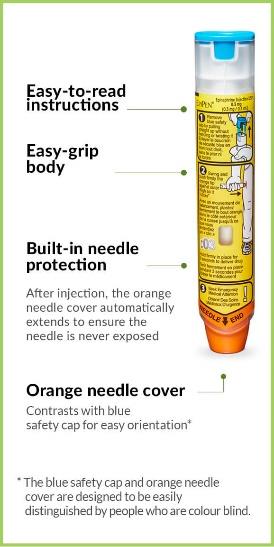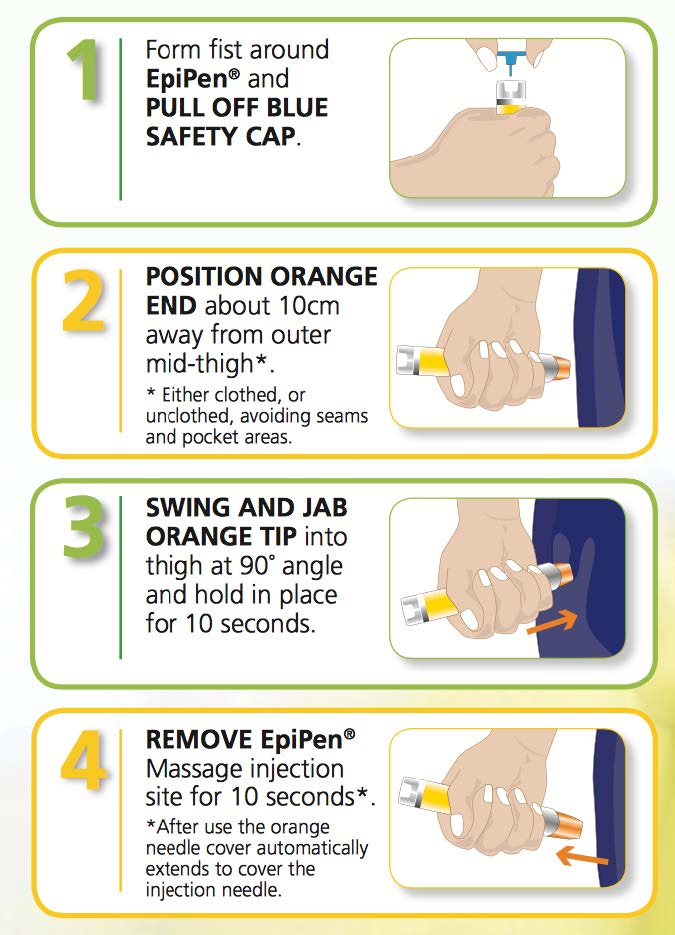Jessica Dunn, Office Manager at Katherine Harriet explains everything you need to know about using an EpiPen
 An EpiPen, a brand of epinephrine (adrenaline) auto-injector, can be a lifesaving device for people experiencing severe allergic reactions, known as anaphylaxis. Recognising the signs of anaphylaxis and knowing how to use an EpiPen, can make a critical difference in emergency situations, as this quick injection of epinephrine can help halt a potentially deadly reaction. This blog will cover when an EpiPen should be used, why it’s essential, and step-by-step instructions on how to use one effectively, and when we might see one being used in community care.
An EpiPen, a brand of epinephrine (adrenaline) auto-injector, can be a lifesaving device for people experiencing severe allergic reactions, known as anaphylaxis. Recognising the signs of anaphylaxis and knowing how to use an EpiPen, can make a critical difference in emergency situations, as this quick injection of epinephrine can help halt a potentially deadly reaction. This blog will cover when an EpiPen should be used, why it’s essential, and step-by-step instructions on how to use one effectively, and when we might see one being used in community care.
When would you use an Epipen, in community care
EpiPens may be seen to be used by anyone we come in contact with, but more specifically, the clients we support and the staff we work alongside. All of our clients will have this documented within the care plan, and a staff member would have a risk assessment in place, and with their agreement, this would be shared with the team, in case of emergency situations and the need to support a staff member arises.
The reasons an EpiPen can be used, includes the following:
- Food allergies
- Insect stings and bites
- Medication allergies
- Latex allergies
- Environmental or unknown triggers
Symptoms and why it is used
We have already established when we may use an EpiPen, but lets take a look at how it works. The EpiPen is an auto injector filled with adrenaline, this is a medication that quickly reverses the symptoms of a severe allergic reaction. Anaphylaxis can occur within minutes of exposure to an allergen, such as food, insect venom, latex, or certain medications. Symptoms include difficulty breathing, swelling, skin rashes, rapid heart rate, and a drop in blood pressure, this can cause to shock if left untreated.
The Adrenaline works by:
- Constructing blood vessels, which increases blood pressure
- Relaxing muscles in the airways, to improve breathing
- Reducing swelling, and alleviating symptoms such as hives or rashes
When should an EpiPen be used
We have looked at why we use an EpiPen, now let’s take a look at when we should use the EpiPen. Although it may seem intimidating at first, it is designed to be a simple and quick procedure, that anyone can use, see below the step-by-step guide:
 Prepare the EpiPen
Prepare the EpiPen
- Hold the EpiPen firmly with your dominant hand, keeping your fingers clear of both ends. Most EpiPens have a blue cap (safety release) on the top end and an orange tip (needle end) at the bottom.
Remove the Safety Cap
- With your other hand, remove the blue safety cap by pulling it straight up. Once the cap is off, the device is ready for use.
Administer the Injection
- Aim for the middle of the outer thigh, holding the EpiPen perpendicular to the thigh.
- Push the orange tip firmly against the thigh until you hear or feel a click—this signals that the injection has started. Hold the EpiPen in place for about 3 seconds to ensure the medication is delivered.
Remove and Massage
- After 3 seconds, remove the EpiPen from the thigh and massage the area for a few seconds to help distribute the medication.
Seek Emergency Assistance
- Call 911 (or your local emergency number) immediately after administering the injection, even if the person seems to feel better. Symptoms can recur, and further medical treatment may be necessary.
Use a Second EpiPen if Necessary
- In some cases, symptoms may return before emergency personnel arrive. Most doctors recommend carrying two EpiPens, as a second dose may be needed 5-15 minutes after the first if symptoms persist.
Important Tips and Considerations
- Storage: Keep EpiPens at room temperature and away from direct sunlight. Extreme temperatures can reduce the medication’s effectiveness.
- Expiration Dates: Regularly check the expiration date on your EpiPen, as expired devices may not work properly. Replace them as needed.
- Teach Others: Educate family members, friends, and coworkers on where your EpiPen is stored and how to use it. This can be lifesaving if someone else needs to administer it during an emergency.
Video – How To
Check out this video, that will give you visual training on the EpiPen – and save a life today!
https://www.youtube.com/watch?v=Ak74MWMicOE
Tel: (01432) 483083
Email: info@katherineharriet.care
Jessica Baynham
Office / Administration Manager


